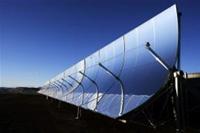Desertec - the new Desert Sun
Ralitsa Kovacheva, February 22, 2010
 The most ambitious project for renewable energy Desertec continues to grow. Five more companies from Moroccos, Tunisia, Spain, France and Italy will join the initiative, which was started last year by 12 mainly German companies (among which Siemens, E.ON, RWE, Deutsche Bank, Munich Re). The project, to cost 400 bn euro, aims by 2050 15% of electricity, consumed in Europe, to be produced by this revolutionary installation in the Sahara desert.
The most ambitious project for renewable energy Desertec continues to grow. Five more companies from Moroccos, Tunisia, Spain, France and Italy will join the initiative, which was started last year by 12 mainly German companies (among which Siemens, E.ON, RWE, Deutsche Bank, Munich Re). The project, to cost 400 bn euro, aims by 2050 15% of electricity, consumed in Europe, to be produced by this revolutionary installation in the Sahara desert.
The idea is the sun light to be collected through a system of mirrors in special containers. The thermal energy, gained this way will produce steam which will activate turbines and produce electricity to be delivered in Europe by high voltage conduits under the Mediterranean. The scale of Desertec makes it the largest and most expensive environmental and infrastructural project ever in history.
The Executive Director of the project Paul van Son expressed satisfaction that companies from the Middle East and North Africa will also join the project because it on their territories that the installations will be placed. In the next 3 years the first demonstration installations are expected to start functioning. Morocco is one of the most serious candidates for the experiment - the country has already defined the places where the mirrors will be set up. This is north of the desert, near populated areas so as to secure enough water for cleaning the mirrors and for cooling the turbines.
Van Son commented that while the demonstration phase of the project was taking place, the respective legislation should be developed with regard to the import of green energy in different European countries as well as to guarantee the price. And for sure will be much higher than the price of nuclear energy or the energy from fossil fuels - between 10 and 20 euro cents per KW/H, depending on the site and technology. This might not seem expensive if the price of protecting the environment is included as well as the creation of new jobs. "We should ensure a good starting base in Europe in the next 3 years so that investors could enter the project", Van Son added underlining that there already are banks, interested in the project.
In fact, interest in the project obviously has been declared on a political level when last year the European Parliament officially announced its support, and a year before that the European Commission started working on the regulatory framework which will allow the project to start. There are enough scientific arguments in support of the initiative: in 6 hours the deserts of the world receive more sunshine than humanity consumes for a whole year. To satisfy the global needs of electricity - 18,000 terawatt/H annually, it will be enough 90,00 square km of the world deserts to be equipped with sun collectors. Around 20 square meters of desert are totally sufficient to satisfy the needs of 1 person of electricity for 1 day.
Not to mention that this is absolutely pure energy which does not emit carbon dioxide. A  research of the German Aerospace Centre show that by 40 years solar-thermal installations will be able to produce more than half of the electricity needed in the region, called EUMENA - this is Europe, the Middle East and North Africa.
research of the German Aerospace Centre show that by 40 years solar-thermal installations will be able to produce more than half of the electricity needed in the region, called EUMENA - this is Europe, the Middle East and North Africa.
Looking for a solution to climate change and the raw materials and energy shortages, humanity turns to the desert. "There's a vast amount of sunshine there," van Son said. "And there are vast amounts of space". But it depends on the people how they will unite their efforts to benefit from the hot desert sun.